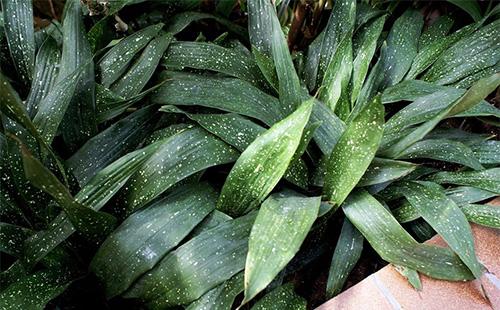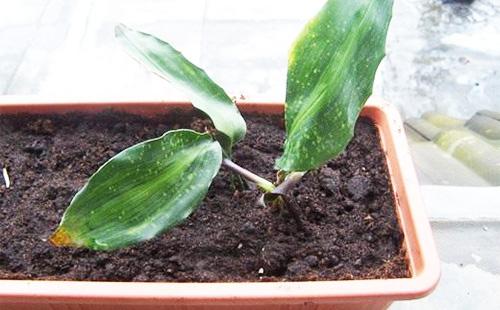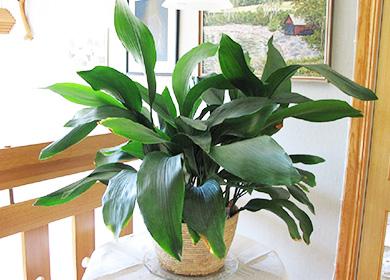The content of the article
Tropical lands of East Asia are considered the birthplace of aspidistra. There, in the shade of cool forests, you can find large, wide leaves of the plant. They begin to flutter when a snake creeps between them. Therefore, at home, the plant began to be called the "pointer of snakes." In indoor floriculture, an aspidistra is considered the most unassuming flower that easily takes root in any room. But some rules for plant care must be adhered to.
Plant description
From the point of view of botany, large leaves of aspidistra are not leaves of a plant. This is the shoots. And the real leaves of the aspidistra are very small, do not have a leaf plate and petiole and resemble scales. Their main task is to ensure the germination of the shoot through the ground. Flowers of aspidistra, as evidenced by reviews, appear very rarely at home. They are extremely unusual and do not correspond to the idea of colors. Inflorescences are formed on the roots, above the ground itself. Small flowers are inconspicuous and even ugly.
The main "indoor" types
The culture belongs to the vast family of asparagus. In the wild, there are about a hundred different species of aspidistra. But in indoor floriculture, only a few varieties were obtained, which are described in the table.
Table - The main "indoor" types of aspidistra and their characteristics
| Type of aspidistra | Culture characteristic |
|---|---|
| High | - Leaf shoots resemble the leaves of a lily of the valley; - leaves are dark green, glossy; - perianth is brown |
| Attenuate | - Leaves are long (about 50 cm) and wide (up to 8 cm); - shoots are dark, with insignificant light impregnations; - rhizome creeping |
| Large flowered | - Leaves obovate; - shoots grow up to 80 cm; - there are contrasting spots on the leaves; - in July, buds appear on the roots; - purple flowers form from the buds |
| Guanjou | - Smooth elliptic leaves; - elongated petiole; - there are yellow chaotic spots on the leaves |
| Sichuan | - Single sheets (about 70 cm); - the leaf is dark green or spotty; - the handle sometimes reaches 40 cm; - blooms in winter; - inflorescences resemble a bell of six petals |
Aspidistra: what care is needed
Even a beginner grower can easily figure out how to care for an aspidistra. The plant is completely unpretentious and is considered one of the easiest indoor flowers to care for. Aspidistra is able to grow even in those conditions in which not a single flower survives.
Location of the aspidistra and lighting
The plant prefers shade. The direct rays of the sun can destroy the iron lady. Therefore, the flower is recommended to be placed away from windows.It can develop normally in the corridor, in large office halls. Florists are advised to adhere to such recommendations for lighting and location.
- In the room. The flower will willingly develop in the northwest or northeast windows. At the same time, you can not even put it on the windows, but put it in the back of the room.
- On the balcony. In summer, the plant can be transferred to the balcony or taken to the terrace. The flower quickly acclimates. But you need to choose a place for a green pet only in the shade.
Temperature
The iron lady does not have any special requirements for the temperature regime. She is even able to withstand cooling to + 5 ° C. Experts advise to adhere to such rules:
- in winter - a suitable temperature for the aspidistra is + 16 ° C;
- summer - the flower absolutely does not like heat, therefore consider the most optimal conditions + 20 ° С- + 22 ° С.

Watering and moisturizing
Aspidistra does not need excessive moisture. Excessive moisture can kill the flower. In the case of apidistra, it is better to under-fill than to fill. So that growing aspidistra at home brings only joy, provide the plant with the following care.
- The frequency of watering. In summer, the soil is moistened immediately after it dries, approximately once every four to five days. In winter, during the cool season, water the aspidistra two to three days after the soil dries. On average, this happens once a week.
- Spraying. Humidity is completely unprincipled. However, regular spraying will favorably affect the appearance of the flower. One spray per week is enough. But if the room is hot, then you can increase the amount of moisture.
- Hygiene. Dust often accumulates on the leaves of the plant. It harms him, spoils his appearance. Therefore, it is recommended to wipe the sheet plates with a cotton pad soaked in plain water as it becomes dirty.
Top dressing
Periodically, it is necessary to pamper the aspidistra with useful substances. This will favorably affect the foliage, give saturation to the shade and enhance the natural shine. However, excessive fertilizer is very dangerous for the plant. Florists recommend feeding their green pet according to the following three rules.
- Frequency of top dressing. Fertilize the plant during intensive growth. Crops with dark green shoots need to be fed once every two to three weeks. Aspidistra with variegated leaves fertilize every 30-45 days, otherwise they will lose their unique "coloring".
- Fertilizer selection. Mineral fertilizers suitable for decorative leafy flowers are suitable for the lady of iron. Aspidistra will favorably react to "Activin", "Master Agro", "Uniflor."
- Winter season. With the onset of hibernation, the plant is no longer fed. It does not need fertilizers until the next growing season.

Transfer
When wondering how to care for an aspidistra after a purchase, many decide to start with a transplant. This is not entirely correct. The plant does not like such an event. Therefore, it is necessary to transplant it only if the pot became really small for the iron lady, and the roots began to grow through the drainage. To transplant the aspidistra properly, follow these five guidelines.
- Time. It is best to transplant the plant in mid-spring. This time coincides with the beginning of the growing season, due to which the aspidistra will normally withstand the “relocation”.
- Age. Only young plants are transplanted. Large aspidistras growing in large tubs are not recommended. They just remove the top ball of soil and add new soil.
- Pot. For aspidistra pick up a large flowerpot and deep. It is desirable that the new pot was 4-5 cm larger in diameter than the old one. Such a pot will allow the root system to develop normally and prevent frequent transplants.
- Priming. The soil of the aspidistra is unpretentious. Universal soil is suitable for her.She loves the soil for palm trees. And if there is a desire, then the earth mixture can be prepared independently by combining in equal proportions turf land, peat, humus and sand.
- Drainage. Fine brick, pebbles or clay shards are necessarily poured at the bottom of the pot. Such a drainage system will allow timely removal of water residues.
Aspidistra has delicate roots. That is why it is not recommended to transplant it often. Florists are advised to carefully transship the plant into a new pot without cleaning the roots of the old soil. This will maximize the preservation of the fragile root system.
Aspidistra breeding methods
Florists prefer to propagate the plant during transplantation. This allows you to protect the culture from additional injuries. Aspidistra can be propagated by three methods. But most often they resort to only one thing - dividing the rhizome. And the rarest method of reproduction is considered to be seed planting. This is a long and complex method, which is used only by experienced growers, trying to get new varieties.
Rhizome
The easiest method. It is only valid for a mature plant that is already five years old. The huge minus of this method is hidden in the need to injure the roots of the aspidistra. And the plant does not tolerate such a procedure quite well.
Reproduction of aspidistra by dividing the bush is performed in four stages.
- During transplantation, the rhizome is carefully shaken from the ground.
- With a sharp knife, cut the root in the selected place so that there are at least five leaves on the new plant.
- “Wounds” are immediately sprinkled with wood ash to protect the root from decay.
- All formed plants are planted in separate pots and moisten the soil.
Leaf
Another simple method of propagation of aspidistra. With this method, the root system is not injured, which is preferable for the iron lady. The leaf rooting process consists of the following five steps.
- Strong healthy leaf and carefully separated from the plant, without affecting the petiole.
- The leaf is lowered into a container of water. The jar is tightly closed.
- An educated greenhouse is set in a warm and bright place.
- As soon as the first roots appear on the leaf, it can be planted in the ground.
- A young plant is covered with a cap and waiting for the appearance of another leaf, indicating the complete rooting of the aspidistra.
Diseases and major pests
The plant is extremely ill and very rarely attacked by pests. Although serious errors in care can easily lead not only to a deterioration in appearance, but also to the death of an iron lady. Therefore, having noticed the first unpleasant symptoms, it is necessary to carefully review the care of the culture and immediately begin treatment. The methods are described in the table.
Table - How to deal with diseases and major pests of aspidistra
| Problem | Cause | What to do |
|---|---|---|
| Dark brown spots on the leaves | Sunburn | - Move to a shaded place |
| Very slow growth | Lack of nitrogen in the soil | - Transplant into a more suitable soil; - make nitrogen fertilizers |
| Withering leaves, their yellowing | Waterlogging of the soil and rotting of the roots | - reduce watering; - transplant into fresh soil; - remove the rotten parts of the root by treating the sections with ash |
| Too dry air and high room temperature | - Spray frequently | |
| Leaves turn pale, and variegated aspidistra lose color | Stands in a place too dark | - Transfer to ambient light |
| Fertilizers selected incorrectly or applied too often | - reduce feeding; - choose suitable fertilizers |
|
| Leaves turn brown, cobwebs appear on them | Spider mite wound | - To carry out spraying; - humidify the air; - apply on the crown “Actellik” |
| Leaves turn yellow, fall, pests are visible | Woundworms | - Collect pests manually; - disinfect leaves with a soap solution; - apply Karbofos, Fufanon |
If, observing all the features of caring for an aspidistra in a pot, you find a rapid yellowing of the leaves, and the same rapid change in the shade of flowers (if any), then your pet is most likely struck by infectious chlorosis. There are no methods to combat such a dangerous disease. In this case, it is necessary to destroy the plant until it has infected other inhabitants of the room flower collection.
Reviews: “The one that shows the snake”
And I broke off part of the rhizome with a leaf from a huge bush that grows in a tub in the workshop of the chemical plant I work for. So there the aspidistra bloomed! On the ground directly lie such types of balls as seed boxes, small in size and open. Looks like thuja seed boxes.
Well, I cut myself three such leaves with rhizome. First put in the water. Well stood. But no growth of those small thick roots that were was observed. Then she planted it in the ground. And it was last year, it seems at the end of summer! So until now these leaves have stood, as canned. They don’t die, but they don’t grow and you can’t see new leaves.Xavier https://iplants.ru/forum/index.php?showtopic=5392
My aspidistra has been hibernating on the street in the ground, under sheltering material, for three years now.
It grows well, especially after division (four healthy plants.), But does not bloom, although it has not been watched. Very hardy plant. I even feel sorry for leaving the yard, he wants to live like that!Note by the moderator: the author lives in Odessa.
@ nn @, https://iplants.ru/forum/index.php?showtopic=5392
Aspidistra has been living with us for about 60 years, the oldest indoor plant, in any case, in the photo 50-52, it is. I love her for her unpretentiousness and ability to grow in the darkest places of the apartment (now on a bookcase in the corner of the room farthest from the window, under the ceiling). And it gives some old-fashioned cosiness.
Friday, http://www.sadiba.com.ua/forum/showthread.php?t=8718
I love this plant, I have been looking for it for a long time, but now it is completely undeservedly forgotten. It’s rare in which store they even know such a name. Of course, I found, acquired, proudly exposed on the windowsill. When the neighbors from the street came to the window to monitor my new thing (I have the first floor), I explained that the one that shows the snake was supposedly. The neighbors were offended, taking it at their own expense. And the grandmother, from whom I bought an aspidistra, said that the infusion of leaves helps with joint pain. I haven’t checked yet. She also said that it can be planted in the flowerbed for the summer. I'll try this year.
Anfisa, http://www.sadiba.com.ua/forum/showthread.php?t=8718

